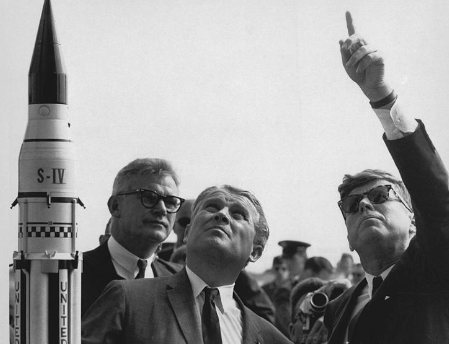During a briefing at Blockhouse 34 of the Cape Canaveral Missile Test Annex in 1962, three of the most important men in the history of American space exploration were photographed sitting in the front row, President John F. Kennedy, who had promised that man would land on the moon by the end of the 1960s, Vice President Lyndon B. Johnson, who would later serve as President during some of the most important missions to outer space, and Kurt Debus, the first ever Director of the Kennedy Space Centre, who previously served as an Staffelrottenführer in the SS and a key architect in the Nazi V2 Rocket Project, which resulted in the deaths of thousands of people.

By May 1945, the Third Reich was in pieces. With the Führer dead, many high ranking Nazis and military officers, fearing Allied capture for their part in war crimes, including the Holocaust, either committed suicide or fled to South America. Most notably, Martin Bormann, Nazi Party Minister, Joseph Goebbels, Reichminister of Propaganda and Chancellor, and Reichsführer SS Heinrich Himmler all committed suicide in the final days of the war or in the weeks following, whilst Josef Mengele, a physician and anthropologist, specialising in human experimentation at Auschwitz, and Adolf Eichmann, a high ranking Party Member and Government Official, fled to Argentina, with the latter of the two being captured and executed in 1961 for his role in designing the Holocaust.
However, SS Sturmbannführer Wernher von Braun was less worried than most. In fact, he was bordering on confident, having approached the United States directly with his location, patiently and calmly waiting for their arrival. As a key architect behind the V2 Rocket, Braun was confident that his knowledge would be useful to the United States Government. As predicted, his captors gave him a warm welcome.

What was more surprising, however, that this was occurring all across the collapsing Third Reich and during the years of occupation by the Allies. Whilst the Second World War had concluded, the Cold War was beginning to brew, and the Americans were determined on getting the upper hand against the Soviet Union. In all, over 1,500 Nazi Scientists were extracted from Germany between 1945 and 1962, in order to work on the American Space Programme, including Braun and the aforementioned Debus. Whilst Braun had handed himself over to the Americans, other scientists had to be found and extracted. These missing scientists were compiled in a list that, in an unsuccessful effort to dispose of evidence, was flushed down the toilet.
The operation, Operation Paperclip, was named after the paperclips that they would attach to the files, indicating they contained classified information such as Nazi affiliation or suspected war crimes and that all these should be overlooked in the name of advancing American science. For instance, Braun had overseen an SS Operation that involved forced labour at concentration camps.

The United States was not the only one involved in this practice. Whilst the British and French did not have the resources to exfiltrate German scientists without kidnapping or stealing patents, the Soviets used other more brutal methods in order to get the information they needed, such as bribery and forced relocation. The US method was the most controversial, however, offering a clean slate, the willing relocation of entire families and US citizenship.
Naturally, this massive influx of Germans into the United States raised a lot of eyebrows in the media. In response, the government did what every politician learns not to do on day 1 and told the truth. Immediately, there was mass public outcry, from influential figures such as Albert Einstein and Eleanor Roosevelt, as well as from the National Association for the Advancement of Colored People (NAACP).

Many criticised that the victims of these mens atrocities in the Holocaust struggled greatly to get US Citizenship, ultimately to often get denied whilst the men who perpetrated the Holocaust got a fast track. In addition, there were also those who criticised the fact that former Nazis were now in Government positions, from an aspect of national security. However, as Cold War tensions grew, the argument that these scientists were necessary to combat the Soviet threat grew increasingly stronger.
Braun’s work at NASA involved getting the first American Satellite into orbit after the Soviet Sputnik, as well as the creation of the Saturn V rocket, which helped man land on the Moon. The work of other scientists involved in Paperclip ended up creating the jet engine and advanced pharmaceuticals research, but also developed chemical weapons such as Agent Orange, well known for its use in the Vietnam War.

Whilst these advances in science allowed the US Government to brand paperclip as success, hindsight casts doubt on this judgement. Whilst many minds taken to America in Paperclip were seen as geniuses, such as Braun, many were just your average Joe, who, upon contract completion, either returned to Germany or went to normal civilian life, assimilating amongst the populous. The ethical questions about bringing in scientists from such an evil regime to work on projects of national security still do not have full conclusive answers. However, it is undeniable that these men, no matter how abhorrent and evil their past was, changed our understanding of the universe at large.
